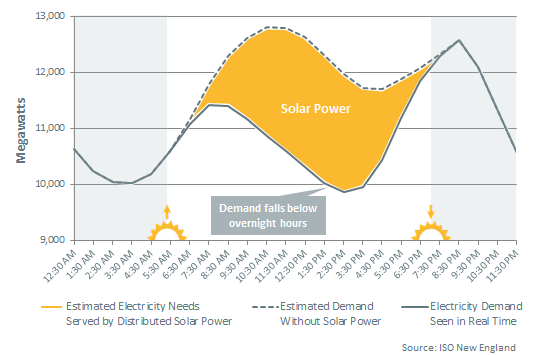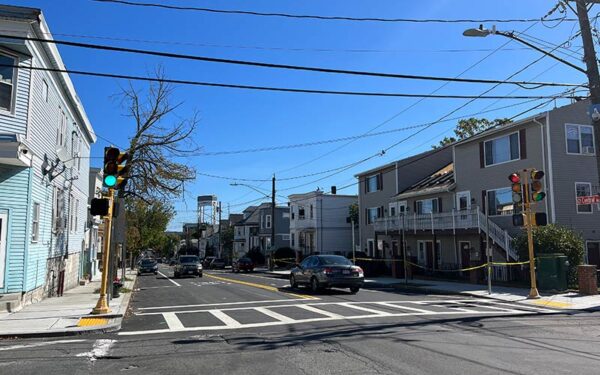
April 21 was further proof that renewable energy like solar can power New England's electricity grid. Photo Credit: Shutterstock.
April 21, 2018 was an historic date for the New England power grid: It was the first time that mid-day peak energy demand from the power grid was lower than at the lowest point overnight. The reason for this historic first is the effectiveness of energy efficiency and the combined output of 130,000 small, medium, and large solar installations in New England.
This first-ever event was marked by ISO-New England, the operator of the New England electricity grid, with a press release, which you can see, here.
What this means for New Englanders is that there is less need than ever for new fossil fuel infrastructure (including both new gas pipelines and new fossil fuel power plants) as more and more lower cost renewables replace older, higher cost fossil fuel power plants.
Demand for Electricity Plummets Due to Solar Energy
This ISO chart shows how those 130,000 individual solar arrays lowered peak demand at 1:30 PM on April 21 by a whopping 2,309 MW from what it would have been otherwise:

That top, dotted line on the chart is what electricity load (that is, demand) in New England would have been but for energy efficiency and solar energy; the bottom, solid line is what electricity load actually was. And the yellow area shows the difference caused by individual homes and businesses using and supplying power generated by their own solar arrays.
The Growth of Solar Means We Don’t Need New Fossil Fuel Infrastructure
And there is more good news: The rate at which new solar panels in New England are being installed is increasing, and the ISO expects that we’ll have over 5,800 MW of solar operating in New England in 2027.
One big reason that this is good news is that the arguments in favor of new natural gas pipelines and fossil fuel plants like Invenergy are closely linked to the level of peak electricity demand in the region; thus, when peak electricity demand declines because of the deployment of renewable energy, the supposed need for new fossil fuel plants disappears too!
And Electricity Customers Are Saving Money
Electricity customers also benefit from increased deployment of renewables because, as I discussed here, increased deployment of renewable energy is bringing down the cost of electricity for all New Englanders. And that is exactly what happened on April 21. The wholesale price of electricity in New England averages about 6¢–7¢ per kilowatt hour over the course of a year. But at 1PM on April 21, the wholesale price of electricity in New England plunged to zero, and at 2PM that day the price went to minus 2¢ per kilowatt hour!
That is, conventional, old-fashioned fossil fuel generators actually had to pay the ISO to take their electricity during the afternoon of April 21 – because so much clean renewable energy was on the system that afternoon! (On April 21, the New England fuel mix for producing electricity consisted of about 31% of conventional fossil fuel and 25% of hydro power and other renewables.)
The Fossil Fuel Era is Ending
Skeptics say that we need new pipelines and fossil fuel plants like Invenergy because relying on renewable energy alone is wishful thinking. But those pushing new fossil fuel infrastructure are behind the times. Today, renewable energy in New England is fully dispatchable in the real-time market, meaning it can be turned on and off as needed. And, renewable energy is getting to be less expensive than electricity from conventional fossil fuels.
And, of course, by far the most important difference between renewables and fossil fuels is that renewable energy does not emit carbon and contribute to the climate change emergency.
So, let’s celebrate April 21 as an historic day in New England, one that signals the new normal for our energy future.



